
1
Copyright 2002 RFM
Virtual Wire
Development Kit Manual
for
DR1200A-DK and DR1201A-DK
Part Number: 400-1543-001a

2
Copyright 2002 RFM
File: 400-1543-001a.doc
2002.08.03 rev
Virtual Wire
Development Kit Manual for DR1200A-DK and DR1201A-DK
Virtual Wire
Development Kit Hardware Warranty
Special Notices
1 Virtual Wire
Development Kit Introduction
1.1
Purpose of the Virtual Wire
Development Kit
1.2
Intended
User
1.3 General Description
1.4
Key
Features
1.5
Development
Kit
Contents
2 Low-Power Wireless Data Communications
2.1
Operational
Considerations
2.2
Regulations
2.3
Example
Applications
2.4
FAQs
3 Developing a Virtual Wire
Application
3.1
Simulating
the
Application
3.2
I/O and Power Considerations
3.3
Communications
Protocol
3.4
Antenna
Considerations
3.5
Internal
Noise
Management
3.6
Final
Product
Testing
3.7
Regulatory
Certification
Regulatory
Authority
Product
Certification
Certification
Testing
4 Installation and Operation
4.1
Development Kit Assembly Instructions
4.2
Data
Radio
Board
Antenna
Options

3
Copyright 2002 RFM
4.3
Protocol Board
RS232
Interface
LED
Functions
Host
Program
Installation
5 Theory of Operation
5.1
Data
Radio
Boards
I/O
Interface
TR1000/TR1001
ASH
Transceiver
Specifications
5.2
Protocol
Board
I/O
Interface
RS232
Interface
Protocol
Microcontroller
CMOS/RS232
Level
Converter
Specifications
5.3
Protocol Firmware
A Drawings
ASH Receiver Block Diagram & Timing Cycle
ASH
Transceiver
Block
Diagram
Antenna
Mounting
DR1200A and DR1201A Data Radio Schematic
DR1200A and DR1201A Data Radio Bill of Materials
DR1200A and DR1201A Data Radio Component Placement
916.5 MHz Test Antenna Drawing
868.35 MHz Test Antenna Drawing
PB1001-2 Protocol Board Schematic
PB1001-2 Protocol Board Component Placement
PB1001-2 Protocol Board Bill of Materials

4
Copyright 2002 RFM
Virtual Wire
Development Kit Hardware Warranty
Limited Hardware Warranty. RF Monolithics, Inc. ("RFM") warrants solely to the purchaser that the
hardware components of the Virtual Wire� Development Kit (the "Kit") will be free from defects in materials
and workmanship under normal use for a period of 90 days from the date of shipment by RFM. This limited
warranty does not extend to any components which have been subjected to misuse, neglect, accident, or
improper installation or application. RFM's entire liability and the purchaser's sole and exclusive remedy for
the breach of this Limited Hardware Warranty shall be, at RFM's option, when accompanied by a valid
receipt, either (i) repair or replacement of the defective components or (ii) upon return of the defective Kit,
refund of the purchase price paid for the Kit. EXCEPT FOR THE LIMITED HARDWARE WARRANTY SET
FORTH ABOVE, RFM AND ITS LICENSORS PROVIDE THE HARDWARE ON AN "AS IS" BASIS, AND
WITHOUT WARRANTY OF ANY KIND EITHER EXPRESS, IMPLIED OR STATUTORY, INCLUDING BUT
NOT LIMITED TO THE IMPLIED WARRANTIES OF NONINFRINGEMENT, MERCHANTABILITY OR
FITNESS FOR A PARTICULAR PURPOSE. Some states do not allow the exclusion of implied warranties,
so the above exclusion may not apply to you. This warranty gives you specific legal rights and you may also
have other rights which vary from state to state.
Limitation of Liability. IN NO EVENT SHALL RFM OR ITS SUPPLIERS BE LIABLE FOR ANY
DAMAGES (WHETHER SPECIAL, INCIDENTAL, CONSEQUENTIAL OR OTHERWISE) IN EXCESS OF
THE PRICE ACTUALLY PAID BY YOU TO RFM FOR THE KIT, REGARDLESS OF UNDER WHAT
LEGAL THEORY, TORT, OR CONTRACT SUCH DAMAGES MAY BE ALLEGED (INCLUDING,
WITHOUT LIMITATION, ANY CLAIMS, DAMAGES, OR LIABILITIES FOR LOSS OF BUSINESS
PROFITS, BUSINESS INTERRUPTION, LOSS OF BUSINESS INFORMATION, OR FOR INJURY TO
PERSON OR PROPERTY) ARISING OUT OF THE USE OR INABILITY TO USE THE KIT, EVEN IF RFM
HAS BEEN ADVISED OF THE POSSIBILITY OF SUCH DAMAGES. BECAUSE SOME STATES DO NOT
ALLOW THE EXCLUSION OR LIMITATION OF LIABILITY FOR CONSEQUENTIAL OR INCIDENTAL
DAMAGES, THE ABOVE LIMITATION MAY NOT APPLY TO YOU.
Special notice on restricted use of Virtual Wire
Development Kits
Virtual Wire� Development Kits are intended for use solely by professional engineers for the purpose of
evaluating the feasibility of low-power wireless data communications applications. The user's evaluation
must be limited to use of an assembled Kit within a laboratory setting which provides for adequate
shielding of RF emission which might be caused by operation of the Kit following assembly. In field testing,
the assembled device must not be operated in a residential area or any area where radio devices might be
subject to harmful electrical interference. This Kit has not been certified for use by the FCC in accord with
Part 15, or to ETSI I-ETS 300 220 regulations, or other known standards of operation governing radio
emissions. Distribution and sale of the Kit is intended solely for use in future development of devices

5
Copyright 2002 RFM
which may be subject to FCC regulation, or other authorities governing radio emission. This Kit may not
be resold by users for any purpose. Accordingly, operation of the Kit in the development of future devices
is deemed within the discretion of the user and the user shall have all responsibility for any compliance
with any FCC regulation or other authority governing radio emission of such development or use, including
without limitation reducing electrical interference to legally acceptable levels. All products developed by
user must be approved by the FCC or other authority governing radio emission prior to marketing or sale
of such products and user bears all responsibility for obtaining the FCC's prior approval, or approval as
needed from any other authority governing radio emission.
If user has obtained the Kit for any purpose not identified above, including all conditions of assembly and
use, user should return Kit to RF Monolithics, Inc. immediately.
The Kit is an experimental device, and RFM makes no representation with respect to the adequacy of the
Kit in developing low-power wireless data communications applications or systems, nor for the adequacy
of such design or result. RFM does not and cannot warrant that the functioning of the Kit will be
uninterrupted or error-free.
The Kit and products based on the technology in the Kit operate on shared radio channels. Radio
interference can occur in any place at any time, and thus the communications link may not be absolutely
reliable. Products using Virtual Wire� technology must be designed so that a loss of communications due
to radio interference or otherwise will not endanger either people or property, and will not cause the loss of
valuable data. RFM assumes no liability for the performance of products which are designed or created
using the Kit. RFM products are not suitable for use in life-support applications, biological hazard
applications, nuclear control applications, or radioactive areas.
RFM and Virtual Wire are registered trademarks of RF Monolithics, Inc. MS-DOS, QuickBASIC, Visual
Basic and Windows are registered trademarks of Microsoft Corporation.

6
Copyright 2002 RFM
1 Virtual Wire� Development Kit Introduction
1.1 Purpose of Virtual Wire
Development Kits
Virtual Wire
Development Kits are tools for evaluating the feasibility of low-power
wireless data communications applications. These kits also facilitates the development
of actual systems. In addition, the modules in these kit are available from RF
Monolithics, Inc. (RFM) for use in system manufacturing.
1.2 Intended Kit User
Virtual Wire
Development Kits are intended for use by professional engineers with a
working knowledge of data communications. The kits themselves are not intended as
end products, or for use by individuals that do not have a professional background in
data communications. Please refer to the Special Notices section in the front of this
manual.
1.3 General Description
Virtual Wire
Development Kits allow the user to implement low-power wireless
communications based on half-duplex packet transmissions. These kits contain the
hardware and software needed to establish a wireless link between two Windows-
based computers with RS232C serial ports. The kits includes two communications
nodes, with each node consisting of a data radio board and host protocol board, plus
accessories. The DR1200A-DK kit operates at 916.5 MHz, and the DR1201A-DK
operates at 868.35 MHz. These kits are configured to demonstrate relatively long
operating distances (100 to 200 meters outdoors depending on the antenna used) and
high noise immunity at an "air rate" of 2000 bps. They also demonstrate "EMC robust"
PCB layout techniques required by European applications that must meet ETSI EN 301
489 EMC Class 2 criteria. See RFM's web site for details on the DR2000-DK and
DR2001-DK development kits for high data rate applications.

7
Copyright 2002 RFM
1.4 Key Features
These Virtual Wire
Development Kits includes a number of key features:
� "Out of the box" operation between two Windows-based PC's
� 3 Vdc low-current UHF data radio transceivers (916.5 or 868.35 MHz)
� Excellent receiver off-channel interference rejection
� Wide dynamic range receiver log detection for resistance to on-channel interference
� Reference antennas
� 4.5 Vdc low-current protocol boards based on an ATMEL AT89C2051
microcontroller
� On-board CMOS logic to RS232C level conversion with bypass provisions for direct
CMOS logic interface
� Packet link-layer protocol with ISO3309 error detection and automatic packet
retransmission; up to 24 message bytes per packet
� DC-balanced data coding and PLL-based "integrate and dump" data recovery for
robust link performance
� Simple host-protocol interface with host and protocol source code examples
� Diagnostic LEDs for system performance evaluation
1.5 Development Kit Contents
� Two data radio transceiver boards
� Two host protocol boards
� Two antennas
� CD containing Manuals, Designer's Guides, Data Sheets and Software
� Quick Start Guide

8
Copyright 2002 RFM
2 Low-Power Wireless Applications
2.1 Operational Considerations
Low-power wireless (RF) systems typically transmit from 0.0001 to 10 mW of power,
and operate over distances of 3 to 200 meters. Once certified to comply with local
communications regulations, they do not require a license or "air-time fee" for
operation. There are more than 100 million systems manufactured each year that utilize
low-power wireless for security, control and data transmission. Many new applications
for low-power wireless are emerging, and sales are expected to top 200 million systems
per year by the middle of the decade.
The classical uses for low-power wireless systems are one-way remote control and
alarm links, including garage door openers, automotive "keyless entry" transmitters, and
home security systems. Recently, a strong interest has developed in two-way data
communications applications. These low-power wireless systems are used to eliminate
nuisance cables on all types of digital products, much as cordless phones have
eliminated cumbersome phone wires. RFM's Virtual Wire
Development Kits are
intended to support the design of these types of low-power wireless applications.
Most low-power wireless systems operate with few interference problems. However,
these systems operate on shared radio channels, so interference can occur at any
place and at any time.
Products that incorporate low-power wireless communications must be designed so that
a loss of communication due to radio interference or any other reason does not create a
dangerous situation, damage equipment or property, or cause loss of valuable data.

9
Copyright 2002 RFM
2.2 Regulations
While low-power wireless products do not have to be individually licensed, they are
subject to regulation. Before low-power wireless systems can be marketed in most
countries, they must be certified to comply with specific technical regulations. In the US,
the FCC issues this certification. In most of Europe and Scandinavia, certification is
based on ETSI standards, etc.
While technical regulations vary from country to country, they follow the same general
philosophy of assuring that low-power wireless systems will not significantly interfere
with licensed radio systems. Regulations specify limitations on fundamental power,
harmonic and spurious emission levels, transmitter frequency stability, and transmission
bandwidth.
2.3 Example Applications
Applications for low-power wireless data communications are growing very rapidly. The
following list of example applications demonstrates the diversity of uses for low-power
wireless technology:
� Wireless bar-code readers and bar-code label printers
� Smart ID tags for inventory tracking and identification
� Wireless automatic utility meter reading systems
� Wireless credit card readers and receipt printers for car rentals, restaurants, etc.
� Communications links for hand-held terminals, HPCs, PDAs, and peripherals
� Portable and field data logging
� Location tracking (follow-me phone extensions, etc.)
� Sports and medical telemetry (non life support)
� Surveying system data links
� Engine diagnostic links
� Polled wireless security alarm sensors

10
Copyright 2002 RFM
� Authentication and access control tags
� Arcade games
2.4 FAQs
1. Why does the Virtual Wire
Development Kit include a packet protocol
microcontroller? Why not connect the data radio board directly to a computer serial
port?
You can hook a data radio board directly to a computer serial port (using an RS232
to 3 V CMOS level converter). However, the results are not likely to be satisfactory.
First, error detection is limited to byte parity checking, which will let many errors go
undetected. Also, the DC balance in the data can be very poor, which will greatly
reduce the data radio's range.
Packet protocol is used extensively in two-way data communications. For example,
the Internet and digital cellular phones use packet transmissions. While there are
many packet protocols in use, they all provide a basic set of features, including an
effective means for transmission error detection, and routing support (such as a "to"
and "from" address). This allows error free data communications to be performed in
a highly automatic way. The protocol microcontroller used in the Virtual Wire
Development Kit provides error detection and automatic message retransmission,
message routing, link failure alarms and DC-balanced packet coding.
2. What is the operating range of my low-power wireless systems?
Testing in an electrically quiet outdoor location, we can easily communicate more
than 100 meters with the DR1200A-DK and DR1201A-DK. However, operating
range in a given situation is influenced by building construction materials and
contents when indoors, and by other radio systems operating in the vicinity, and
noise generated by nearby equipment. The Virtual Wire
Development Kit can be

11
Copyright 2002 RFM
taken into a target environment and used to help gain a sense of operating range for
the proposed system. See the Appendix in the ASH Transceiver Designer's Guide
for additional information.
3. Can I communicate between more than two nodes in the same location with a low-
power communications link?
Yes. One of the benefits of packet transmissions in channel sharing. In the case of
these Virtual Wire
Development Kits, each protocol board can recognize 12
addresses. For example, node 1 can be transmitting bar-code readings to node 2 while
node 4 is transmitting bar-codes to node 7 in the same location. So long as the average
channel usage is less than about 10-12%, randomly transmitted messages will get
though without excessive transmission "collisions" and transmission retries.
3 Developing a Virtual Wire
Application
3.1 Simulating the Application
There are hundreds of potential applications for short-range wireless communications
links. Because there can be so many different variables in a potential application,
simulating the application is often the best way to gain insight into its feasibility. Virtual
Wire
Development Kits can be very helpful in simulating potential applications. The
following simulation check list covers issues common to most low-power wireless
applications. The user should also consider what other specific issues apply to the
application being simulated:
� Maximum operating range required
� Type of operating environment (outdoor, indoor, indoor building construction, etc.)
� Number of nodes (transceivers) required in the application
� Node interaction (communications between pairs of nodes only, one master node
and several slave nodes, communications between any two nodes, etc.)

12
Copyright 2002 RFM
� Possible on-channel interference/noise sources (ISM equipment, electrical
equipment, etc.)
� Channel usage (average and peak number of messages expected in a given period
of time, average message transmission/acknowledgment duration, average
percentage of time the channel is in use, etc.)
� Message characteristics (average and maximum length; message type such as
data, telemetry, control codes, etc.)
� Antenna logistics (omnidirectional, directional, hidden, etc.)
� Environmental considerations
Indoor radio propagation is an issue for special consideration. In most indoor locations,
"dead spots" can be found where reception is very difficult. These can occur even if
there appears to be a line of sight relationship between two nodes. These "dead spots",
or nulls, are due to multiple transmission paths existing between two locations because
of reflections off objects such as steel beams, concrete rebar, metal door, window and
ceiling tile frames, etc. Nulls occur when the path lengths effectively differ by an odd
half-wavelength. Deep nulls are usually very localized, and can be avoided by moving
either node slightly.
Diversity reception techniques are very helpful in reducing indoor null problems. Many
low-power wireless systems involve communications between a master and multiple
slave units. In this case, the master transmission can be sent twice; first from one
master and then again from a second master in a slightly different location. The nulls for
each master will tend to be in different locations, so a slave is very likely to hear the
transmission from one or the other master. Likewise, a transmission from a slave is
likely to be heard by at least one of the masters. Hand-held applications usually involve
some movement, so automatic packet retransmission often succeeds in completing the
transmission as hand motion moves the node through the null and back into a good
transmission point. Diversity reception should be considered when covering indoor
areas larger than about 20 by 20 meters or where the indoor space is broken into many
cubicles, booths, aisles, offices, etc.

13
Copyright 2002 RFM
3.2 I/O and Power Considerations
The DR1200A and DR1201A Data Radio boards require a DC power supply in the range
of 2.7 to 3.3 Vdc with less than 10 mV of ripple, and a peak current capability of up to
15 mA. Quiescent current in the receive mode is approximately 3.5 mA. The average
current with an RF signal being transmitted is approximately 6 mA and the peak current in
the RF transmit mode is approximately 12 mA. Applying more than 3.6 Vdc to the Data
Radio boards or reversing the polarity of the supply voltage will permanently damage
them (note that the Protocol Board operates from 4.5 Vdc but supplies 3 Vdc to the Data
Radio board). Another concern is ESD as static-sensitive devices are used on the Data
Radio board.
3.3 Communications Protocol
Almost all two-way wireless data communications use some form of packet protocol to
automatically assure information is received correctly at the correct destination. The
protocol provided with these Virtual Wire
Development Kits is a link-layer protocol,
and includes the following features:
� 16-bit ISO3309 error detection calculation to test message integrity
� 4-bit TO/FROM address routing with up to 12 different node addresses available
� ASCII or binary message support (using Internet SLIP style framing substitutions for
binary messages where needed), up to 24 payload bytes per packet
� Automatic packet retransmission until acknowledgment is received; 8 retries with
variable back-off delays plus "acknowledge" and "link failure" alarm messages.
The kit CD includes a Visual Basic program with source code to provide an example of
interfacing host (application) software to this Virtual Wire
link layer protocol. The
protocol software does not require or support hardware flow control, so the host
software does some timekeeping to interface the protocol software. Both the protocol
and host software are discussed in the ASH Transceiver Software Designer's Guide on

14
Copyright 2002 RFM
the CD. Users familiar with hardwired packet networks may consider the 24 message
bytes per packet limit quite small. Packets sent by low-power wireless systems are kept
deliberately short to improve performance where on-channel burst interference and low
signal-to-noise conditions are often encountered.
3.4 Antenna Considerations
Suitable antennas are crucial to the success of a Virtual Wire
application. Here are
several key points to consider in designing antennas for your application:
� Where possible, the antenna should be placed on the outside of the product. Also,
try to place the antenna on the top of the product. If the product is "body worn", try to
get the antenna away for the body as far as practical.
� Regulatory agencies prefer antennas that are permanently fixed to the product.
Antennas can be supplied with a cable, provided a non-standard connector is used
to discourage antenna substitution (these connectors are often referred to as
"Part 15" connectors).
� An antenna can not be placed inside a metal case, as the case will shield it. Also,
some plastics (and coatings) significantly attenuate RF signals and these materials
should not be used for product cases where the antenna is inside the case.
� The antenna designs used in the kit are included in the Drawings section of the
manual. Many other antenna designs are possible, but efficient antenna
development requires access to antenna test equipment such as a vector network
analyzer, calibrated test antenna, antenna range, etc. Unless you have access to
this type of equipment, consider using a standardized antenna design or antenna
design consultant. Contact RFM's applications engineering group for additional
information.
� A patch or slot antenna can be used in some applications where an external
antenna would be subject to damage. These types of antennas usually have to be
designed on a case-by-case basis.

15
Copyright 2002 RFM
3.5 Internal Noise Management
RF transceivers operating under FCC Part 15 and similar regulations are sensitive to
noise at their operating frequency, because the desired signals must be transmitted at low
power levels. Commonly encountered internal noise sources are microprocessors (both
for control functions and computer functions), brush-type motors and high-speed logic
circuits. If the rise time and fall time of the clocking pulses in a microprocessor are fast
enough to produce harmonics in the frequency range of the receiver and the harmonics
actually fall within the passband of the receiver, then special care must be taken to
reduce the level of the harmonic at the antenna port of the receiver. It is best to choose a
different microprocessor crystal frequency to avoid this problem. If the engineer has the
option, he should choose a microprocessor that has the slowest rise and fall time he can
use for the application to avoid the troublesome harmonics in the UHF band. If possible,
brush-type motors should be avoided, since arcing of the brushes on the commutator
makes a very effective spark-gap transmitter. If it is necessary to use a brush-type motor,
spark suppression techniques should be used. Such motors can be purchased with spark
suppression built-in. If the motor does not have built-in spark suppression, bypass
capacitors, series resistors and shielding may have to be employed. High-speed logic
circuits produce noise similar to microprocessors. Once again, the engineer should use
logic with the slowest rise and fall times that will work for his application.
The items listed below should be considered for an application that has one or more of
the above noise sources included:
� Locate the RF transceiver and its antenna as far from the noise source as possible.
� If the transceiver must be enclosed with the noise source, remotely locate the antenna
using a coaxial cable.
� Terminate high-speed logic circuits with their characteristic impedance and use
microstrip interconnect lines designed for that impedance.
� Keep PCB traces and wires that carry high-speed logic signals or supply brush-type
motors as short as possible. Such lines act as antennas that radiate the unwanted
noise.

16
Copyright 2002 RFM
� If possible, enclose the noise source in a grounded metal box and use RF decoupling
on the input/output lines.
� Avoid using the same power lines for the RF transceiver and the noise source or at
least thoroughly filter (RF decouple) such power lines. It is advisable to use separate
voltage regulators.
� If the antenna cannot be remotely located, place it as far from the noise source as
possible (on the opposite end of the printed circuit board). Orient the antenna such
that its axis is in the same plane with the printed circuit board containing the noise
source. Do not run wires that supply the noise source in close proximity to the
antenna.
3.6 Final Product Testing
Any wireless data communications system must be thoroughly tested due to the
"anything can happen in any sequence" nature of wireless communications. It is highly
recommended that beta sites be chosen for operational system testing which represent
the "limit" situations the system can be expected to operate in.
Testing for regulatory certification is discussed in Section 3.7. It is recommended that
the user either establish an RF test range or a working relationship with a recognized
test lab early in the system development phase, to allow for periodic evaluation of the
system's emissions during development. Many labs are experienced in solving radiation
problems that cause certification test failures and/or jamming of the low-power wireless
link. Identifying these types of problems early can save a lot of development time.

17
Copyright 2002 RFM
3.7 Regulatory Certification
Regulatory Authority - Worldwide, man-made electromagnetic emissions are controlled
by international treaty and the ITU (International Telecommunications Union) committee
recommendations. These treaties require countries within a geographical region to use
comparable tables for channel allocations and emission limits, to assure that all users
can operate with reasonable levels of interference.
Recognizing a need to protect their limited frequency resources, many countries have
additional local laws, regulations and government decrees for acceptable emission
levels from various electronic equipment, both military and commercial. By requiring
that each model of equipment be tested and an authorization permit issued, a
government works to control the sale of problematical equipment and also has record of
the known manufacturers.
Enforcement and expectation of the local law varies, of course. USA, Canada, and
most European countries have adopted ITU tables for their respective radio regions.
Australia, Hong Kong and Japan also have extensive rules and regulations for low
power transmitters and receivers, but with significant differences in the tables for that
radio region. Most other countries have less formal regulations, often modeled on either
USA or EU regulations.
In any country, it is important to contact the Ministry of Telecommunications or Postal
Services to determine any local limitations, allocations, or certifications PRIOR to
assembling or testing your first product.
These laws and requirements are applicable to the finished product, in the configuration
that it will be sold the general public or the end user. OEM components often can not be
certified, since they require additional non-standard attachments before they have any
functional purpose.

18
Copyright 2002 RFM
Unless otherwise marked, RFM Virtual Wire
Development Kit modules have not been
certified to any particular set of regulations. Each module has suggested countries for
use, depending on current allocations and technical limits. Emissions from receivers
can be an unexpected problem, and the RFM modules have special features to help
with this part of the emission testing.
Product Certification - General requirements for emissions and ingressions ( called
susceptibility) are controlled by engineering standards of performance, regulations, and
the customer's expectations.
In USA and Canada, for example, you must formally measure the emissions, file for a
certification or authorization, and affix a permanent marking label to every device, prior
to offering your system for retail sale. Regulations allow you to build a small number for
testing and in-company use before certification and marketing. Trade shows and
product announcements can be a problem for marketing, when the products are
advertised without proper disclaimers. With Internet access, go to "www.fcc.org" for
USA information or "www.ic.gc.ca" for Canada. The Canada rules are RCC-210,
Revision 2. FCC CFR 47, Parts 2 and 15, contains the needed information for USA
sales.
European Union (EU) requirements allow self-certification of some systems and require
formal measurement reports for other systems. In all cases, however, the directives
demand the "CE mark" be added to all compliant devices before any device is freely
shipped in commerce. In the EU, the EMC Directive also adds various tests and
expectations for levels of signal that will permit acceptable operation.
Certification Testing -
The emissions are measured in a calibrated environment defined
by the regulations. USA and Canada use an "open field" range with 3 meters between
the device under test (DUT) and the antenna. The range is calibrated by measurement
of known signal sources to generate range attenuation (correction) curves in
accordance with ANSI C63.4-1992.

19
Copyright 2002 RFM
EU measurement rules are based on a similar arrangement, but a "standard dipole"
antenna is substituted for the DUT to calibrate the range attenuation. Since the EU
measurements are comparison or substitution rules, they are often easier to follow for
informal pre-testing by the designer. ETSI 300 220 has drawings that describe a typical
test configuration.
The United States and Canadian requirements are contained in ANSI C63.4-1992,
including a step-by-step test calibration and measurement procedure. Since these rules
include range attenuation factors, one must make twice the measurements of the EU
test method. Other countries follow one of these two techniques, with exception for a 10
meter range (separation) measurement or a different range of test frequencies.
Each of the listed contacts will have resources to provide current regulations and
certification forms. They also can suggest sources for your formal tests, either
commercial labs or the government testing office. Unless you want to invest in a
qualified radiated signals test range, the commercial labs can help you with preliminary
measurements and some expertise in correcting any difficulties that are noted.
Contacts for further information and current test facilities listings:
ANSI
Institute of Electrical & Electronics Engineers,
345 East 47th Street, New York, NY 10017 USA
ETSI
European Telecommunications Standard Institute
F-06921 Sophia Antipolis Cedex FRANCE
FCC
Federal Communications Commission
Washington DC 20554 USA
Canada DOC
Industrie Canada
Attn: Certification, Engineering and Operations Section,
1241 Clyde Avenue, Ottawa K1A 0C8 CANADA
UNITED KINGDOM
LPRA (manufacturing association information)
Low Power Radio Association

20
Copyright 2002 RFM
The Old Vicarage, Haley Hill, Halifax HX3 6DR UK
or
Radiocommunications Agency (official)
Waterloo Bridge House, Waterloo Road
London SE1 8UA
JATE
Japan Approvals Institute (JATE)
Isomura Bldg, 1-1-3 Toranomon
Minato-ku Tokyo JAPAN
4 Virtual Wire� Development Kit Installation and Operation
4.1 Development Kit Assembly Instructions
Kit assembly includes the following steps:
� Install the antennas on the data radio boards
� Obtain and install AAA batteries in the protocol boards (power switch OFF)
� Plug the data radio boards onto the protocol boards
� Install a jumper on ID0 of one of the protocol board (Autosend) to test the Virtual
Wire
communication link by itself
� Remove ID0 jumper and connect 9-Pin PC cables between the protocol boards and
the host computers
� Install the host program on the computers
� Configure the host programs and retest the Virtual Wire communications link using
the host computers
Take care in plugging a transceiver board into a protocol board. The transceiver board
must be oriented so that THE BOARD RESTS ON THE NYLON SCREW SUPPORTS
AND NOT OVER THE BATTERIES. Be sure that the transceiver board pins are
correctly plugged into the protocol board connector. It is possible to plug the transceiver
board in so that a pin is hanging out on the left or right. BE SURE TO INSPECT THE
CONNECTOR ALIGNMENT BEFORE APPLYING POWER. Options and adjustments
are discussed below:

21
Copyright 2002 RFM
4.2 Data Radio Boards
The DR1200A Data Radio board is configured to operate at a data rate of 2000 bps on
a frequency of 916.50 MHz, and the DR1201A is configured to operate at 868.35 MHz.
The kits are shipped with a pair of data radio boards and matching antennas. Data
Radio boards with antennas can be purchased separately for development of
applications.
Antenna Options- The antennas supplied with the kit can be soldered into the antenna
"eyelets" on the Data Radio PCBs. Straighten out the "L" bend at the bottom of the
antennas before installing (see the Drawings section of the manual). These antennas are
simple center-loaded monopoles. Alternatively, a 50 ohm coaxial cable (RG-178, etc.) can
be soldered to the RF antenna eyelet (coax center conductor) and the adjacent ground
eyelet (coax shield), if a remotely located antenna is used. The remote antenna should
have and impedance of approximately 50 ohms, preferably with a VSWR of less than 2:1.
A remote antenna is necessary if the transceiver is housed inside a metal box, which is
very desirable if a noise source such as a high-speed microprocessor, high-speed logic or
a brush-type motor is mounted in close proximity to the transceiver board itself.
4.3 Protocol Board
Programming � When using the DK200A protocol software (RFM part number
SW0012.V01) provided with the "A" series kits, there are two options that can be
programmed on the protocol board. Placing a jumper on ID0 of one protocol board
activates the built-in Autosend mode. This allows the kit to be tested without having to
hook the protocol boards to host PCs (useful for range testing). Placing a jumper on ID3
of one board strips the packet framing and header characters off the packets it
receives. This can be handy for driving small serial printers, etc.
Power Supply - Each node can be operated from three 1.5 V AAA batteries.

22
Copyright 2002 RFM
RS232 Interface - Level conversion from CMOS to RS232 levels is provided by the
MAX 218 IC. It is possible to remove this IC and jumper socket Pin 7 to 14 and Pin 9 to
12 for direct CMOS operation.
LED Functions - Three LED indicators are provided on the protocol board. With the
supplied protocol software, the LED labeled RXI indicates a valid packet start symbol
has been detected. The LED RF RCV indicates that a valid RF packet has been
received (no errors detected by the FCS). The LED PC RCV indicates that a message
is being sent/received from the host PC.
4.4 Host Program Installation
The supplied Windows host terminal programs(s) are installed using Windows Explorer.
Go to the Windows Host Software folder on the CD and then to the V110T30C Install
folder and click on SETUP.EXE. As the install program runs, you will be asked for a
folder name to store the host program files and a Start/Programs menu name ("Virtual
Wire" suggested). Check the Kit CD and RFM's web site
www.rfm.com
for
additional/future Software.
5 Theory of Operation
5.1 Data Radio Boards
I/O Interface- Referring to the Data Radio Board schematic diagram, connector P1 is the
interface connector to the protocol board. Pin 1 is the transmitter data input and can be
driven directly by a CMOS gate. The transmitter is pulse ON-OFF modulated by a signal
on this line changing from 0 to 3 volts. A high level turns the transmitter on and a low level
turns it off. The input impedance to this line is approximately 4.7 kilohms. Pin 2 is a Vcc
line for the TR1000/TR1001 ASH transceiver.

23
Copyright 2002 RFM
Pin 3 is the PTT line that enables the transmit mode. This line puts the TR1000 (or
TR1001) in the transmit mode when it is high (2.5 volts minimum at 2.0 mA maximum).
Pin 4 is a Vcc line connected in parallel with Pin 2. Pin 5 is ground. Pin 6 is unused. Pin 7
is a Vcc line, connected in parallel with Pin 2 and Pin 4. Pin 8 the data output pin from the
transceiver. This data output is CMOS compatible and is capable of driving a single
CMOS gate or a bipolar transistor with a 510 K base resistor. The last connection to the
data radio board is the 50 ohm antenna input. The antenna can either be connected
directly to the board or connected remotely by using a 50 ohm coaxial cable.
TR1000/TR1001 ASH Transceiver - The heart of the DR1200A Data Radio board is the
TR1000 ASH transceiver (DR1201A uses the TR1001). This miniature ceramic-metal
hybrid provides 2-way RF communication of data. The following section provides an
introduction to the ASH transceiver's features, capabilities, theory of operation and
configurability. Additional information can be found on the CD.
ASH Transceiver Features
� Designed for short-range wireless data communications
� Supports RF data rates up to 115.2 kbps
� 3 Vdc , low current operation with integrated power down function
� Stable, easy to use, with all critical RF functions contained in the hybrid
� Robust receiver performance with full sensitivity up to 1 GHz
� Highly configurable with a minimum of external parts
� Choice of OOK or ASK transmitter modulation
� Rugged, miniature ceramic-metal package
� Low implementation cost
� Easy certification to FCC, ETSI and similar low-power radio regulations
RFM's amplifier-sequenced hybrid (ASH) transceivers are ideal for short-range wireless
data communications where small size, low power consumption and low cost are
required. All critical RF functions are contained in the hybrid, simplifying and speeding

24
Copyright 2002 RFM
design-in. The receiver section is sensitive and stable. Two stages of SAW filtering
provide excellent receiver out-of-band rejection. The transmitter includes provisions for
on-off keyed (OOK) or amplitude-shift keyed (ASK) modulation. The transmitter
employs SAW filtering to suppress output harmonics, facilitating compliance with FCC
15.249, ETSI I-ETS 300 220 and similar low-power radio regulations.
ASH transceiver technology offers a rich set of enabling features in short-range wireless
applications. Key features include:
� Small size - the ASH transceiver package footprint is nominally 0.28 x 0.40 inch,
with a package volume of only 0.009 in
3
(146 mm
3
). Transceiver operation is
configured using a dozen miniature passive components, making is practical to add
short-range wireless data connectivity to a watch, pen, PDA, etc.
� Low power - the ASH transceiver operates from 3 Vdc, drawing only 6 mA average
in transmit and 1.65 to 4.5 mA in receive (set-up dependent). In addition, the
transceiver has an integrated power-down mode to support long duration operation
from small batteries.
� Robust operation - the ASH transceiver is a single-channel data radio, employing
amplitude-shift keyed modulation. But unlike simple AM systems, extensive
consideration has been given to operating robustness in the transceiver
architecture. The receiver chain includes a narrow-band SAW filter and a SAW
delay line, which together provide excellent out-of-band rejection. The logarithmic
receiver detector features more than 70 dB of dynamic range. This can be combined
with 30 dB of AGC (optional), providing 100 dB of overall receiver dynamic range.
Data is recovered from the detected base-band signal using a compound data slicer
which provides both excellent threshold sensitivity for low-level signals and good
rejection of interference 8-10 dB below the peak level of stronger desired signals.
Operating robustness is inherent in the signal processing of the radio itself,

25
Copyright 2002 RFM
providing considerable flexibility in the choice of data protocols that can be used with
the transceiver
ASH Transceiver Operation
The ASH transceiver's unique feature set is made possible by its system architecture.
The heart of the transceiver is the amplifier-sequenced receiver section, which provides
over 105 dB of stable RF and detector gain without any special shielding or decoupling
provisions. Stability is achieved by distributing the total RF gain over time. This is in
contrast to a superheterodyne receiver, which achieves stability by distributing total RF
gain over multiple frequencies.
Refer to the Block Diagram and Timing Cycle drawing in Section A of the manual for
the following discussion. This drawing shows the basic amplifier-sequenced receiver
architecture. Note that the bias to RF amplifiers RFA1 and RFA2 are independently
controlled by a pulse generator, and that the two amplifiers are coupled by a surface
acoustic wave (SAW) delay line, which has a typical delay of 0.5 �s.
An incoming RF signal is first filtered by a narrow-band SAW filter, and is then applied
to RFA1. The pulse generator turns RFA1 ON for 0.5 �s. The amplified signal from
RFA1 emerges from the SAW delay line at the input to RFA2. RFA1 is now switched
OFF and RFA2 is switched ON for 0.55 �s, amplifying the RF signal further. The ON
time for RFA2 is usually set at 1.1 times the ON time for RFA1, as the filtering effect of
the SAW delay line stretches the signal pulse from RFA1 somewhat. As shown in the
timing diagram, RFA1 and RFA2 are never on at the same time, assuring excellent
receiver stability. Note that the SAW filter and delay line act together to provide very
high receiver ultimate rejection.
Amplifier-sequenced receiver operation has several interesting characteristics that can
be exploited in system design. The RF amplifiers in an amplifier-sequenced receiver
can be turned on and off almost instantly, allowing for very quick power-down (sleep)

26
Copyright 2002 RFM
and wake-up times. Also, both RF amplifiers can be off between ON sequences to
trade-off receiver noise figure for lower average current consumption. The effect on
noise figure can be modeled as if RFA1 is on continuously, with an attenuator placed in
front of it with a loss equivalent to 10*log
10
(RFA1 duty factor), where the duty factor is
the average amount of time RFA1 is ON (up to 50%).
Please refer to the ASH Transceiver Block Diagram in Section A for the following
discussion:
Antenna port - the only external RF components needed for the ASH transceiver are
the antenna, antenna matching coil and electrostatic discharge (ESD) protection choke.
Receiver chain - the narrow-band SAW filters provides high receiver RF selectivity. The
output of the SAW filter drives amplifier RFA1. This amplifier includes provisions for
detecting the onset of saturation (AGC Set), and for switching between 35 dB of gain
and 5 dB of gain (Gain Select). AGC Set is an input to the AGC Control function, and
Gain Select is the AGC Control function output. ON/OFF control to RFA1 (and RFA2) is
generated by the Pulse Generator & RF Amp Bias function. The output of RFA1 drives
the low-loss SAW delay line, which has a nominal delay of 0.5 �s. Note that the SAW
RF filter and SAW delay line both contribute to the excellent out-of-band rejection of the
receiver.
The second amplifier, RFA2, provides 51 dB of gain below saturation. The output of
RFA2 drives an active full-wave detector with 19 dB of gain. The onset of saturation in
each section of RFA2 is detected and summed to provide a logarithmic response. This
is added to the output of the full-wave detector to produce an overall detector response
that is linear for low signal levels, and transitions into a log response for high signal
levels. This combination provides excellent threshold sensitivity and more than 70 dB of
detector dynamic range. In combination with the 30 dB of AGC range in RFA1, more
than 100 dB of receiver dynamic range can be achieved.

27
Copyright 2002 RFM
The detector output drives a three-pole, 0.05 degree equiripple low-pass filter response
with excellent group delay flatness and minimal pulse ringing. The 3 dB bandwidth of
the filter is adjusted with a single external resistor to match the data rate and data
encoding of the transmitted signal.
The filter is followed by a base-band amplifier which boosts the detected signal to the
BBOUT pin, which is coupled to the CMPIN pin or to an external data recovery process
(DSP, etc.) by a series capacitor.
When the transceiver is placed in power-down or in a transmit mode, the output
impedance of BBOUT becomes very high. This feature helps preserve the charge on
the coupling capacitor to minimize data slicer stabilization time when the transceiver
switches back to the receive mode.
Data Slicers - The CMPIN pin drives two data slicers, which convert the analog signal
from BBOUT back into a data stream. The best data slicer choice depends on the
system operating parameters. Data slicer DS1 is a capacitor-coupled comparator with
provisions for an adjustable threshold. DS1 provides the best performance at low
signal-to-noise conditions. The threshold, or squelch, offsets the comparator's slicing
level, and is set with a resistor between the RREF and THLD1 pins. This threshold
allows a trade-off between receiver sensitivity and output noise density in the no-signal
condition. S2 is a "dB-below-peak" slicer. The peak detector charges rapidly to the peak
value of each data pulse, and decays slowly in between data pulses (1:1000 ratio). The
slicer trip point can be set from 0 to 12 dB below this peak value with a resistor between
RREF and THLD2. DS2 is best for ASK modulation where the transmitted signal has
been shaped to minimize signal bandwidth.
AGC Control - The output of the Peak Detector also provides an AGC Reset signal to
the AGC Control function through the AGC comparator. The purpose of the AGC
function is to extend the dynamic range of the receiver, so that two transceivers can
operate close together when running ASK and/or high data rate modulation. The AGC

28
Copyright 2002 RFM
also prevents receiver saturation by a strong in-band interfering signal, allowing
operation to continue at short range in the presence of the interference. The onset of
saturation in the output stage of RFA1 is detected and generates the AGC Set signal to
the AGC Control function. The AGC Control function then selects the 5 dB gain mode
for RFA1. The AGC comparator will send a reset signal when the Peak Detector output
(multiplied by 0.8) falls below the fixed reference voltage for DS1. A capacitor at the
AGCCAP pin avoids AGC "chattering" during the time the signal propagates through the
log detector, low-pass filter and charges the peak detector. The AGC capacitor also
allows the AGC hold-in time to be set longer than the peak detector decay time to avoid
AGC chattering during runs of "0" bits in the received data stream. Note that AGC
operation requires the peak detector to be functioning, even if DS2 is not used. AGC
operation can be defeated by connecting the AGCCAP pin to VCC, or latched ON
connecting a resistor between the AGCCAP pin and ground.
Receiver pulse generator and RF amplifier bias - The receiver amplifier-sequence
operation is controlled by the Pulse Generator & RF Amplifier Bias module, which in
turn is controlled by the PRATE and PWIDTH input pins, and the Power Down Control
Signal from the Modulation & Bias Control function.
Transmitter chain - the transmitter chain consists of a SAW delay line oscillator TXA1,
followed by a modulated buffer amplifier TXA2. The SAW filter suppresses transmitter
harmonics to the antenna. Note that the same SAW devices used in the amplifier-
sequenced receiver are reused in the transmit modes.
Transmitter operation supports two modulation formats, on-off keyed (OOK)
modulation, and amplitude-shift keyed (ASK) modulation. When OOK modulation is
chosen, the transmitter output turns completely off between "1" data pulses. When ASK
modulation is chosen, a "1" pulse is represented by a higher transmitted power level,
and a "0" is represented by a lower transmitted power level. OOK modulation provides
compatibility with first-generation ASH technology, and provides for power conservation.
ASK modulation must be used for high data rates (data pulses less than 30 �s). ASK

29
Copyright 2002 RFM
modulation also allows the transmitted pulses to be shaped to control modulation
bandwidth. The transmitter RF output voltage is proportional to the input current to the
TXMOD pin, which modulates TXA2. A resistor in series with TXMOD adjusts the peak
transmitter output power.
The four transceiver operating modes - receive, transmit ASK, transmit OOK and
power-down ("sleep"), are controlled by the Modulation & Bias Control function, and are
selected with the CNTRL1 and CNTRL0 control pins. CNTRL1 and CNTRL0 are CMOS
compatible inputs.
ASH Transceiver Configurability
ASH transceivers are highly configurable, offering the user great flexibility in optimizing
for specific applications and protocol formats. The operating configuration is set using
low-cost resistors and capacitors. Key points of configurability include:
� Adjustable receiver sensitivity versus current consumption
� Adjustable receiver low-pass filter to support various data rates/encoding techniques
� Adjustable peak transmitter output power
� Conventional or "dB below peak" data slicer select
� Adjustable thresholds (squelch settings) for each data slicer
� Adjustable AGC hold-in time and AGC latch/defeat function
� OOK or ASK modulation with adjustable ASK modulation depth
� Continuous or duty-cycled operation (integrated power down function)
� 2.7 to 3.5 Vdc power supply range (down to 2.2 Vdc over limited temperature range)
Data Radio Board Specifications
Operating Frequency
DR1200A
916.5
MHz
DR1201A
868.35
MHz

30
Copyright 2002 RFM
Modulation On-Off
Keyed
Antenna
50
ohm
Operating Data Rate
2000 bps (500 �s min. pulse width @ TX input)
TX Frequency Tolerance
less than �200 kHz, including set-on, temperature
and aging drift
TX
Output
Power -1
dBm
nominal
TX
Harmonics less
than
-55
dBc
Receiver Performance
BER less than 10E-4 for a -100 dBm input (2000 bps)
RX Pulse Distortion
less than �10% for a 500 �s TX pulse
RX Dynamic Range
-100 to 0 dBm
Data DC Balance
receiver performance shall be maintained for
data
with
an
average
"1"
density
from
45
to
55%
Data Run Length
receiver performance shall be maintained for
"1"
or
"0"
run
lengths
of
at
least
4
bits
RX Off-Channel Rejection
DR1200A-DK
greater than 70 dB, 0.25 to 870 MHz and
962 to 2500 MHz
DR1201A-DK
greater than 70 dB, 0.25 to 825 MHz and
911 to 2500 MHz

31
Copyright 2002 RFM
RX On-Channel Rejection
less than 30% BER degradation for an interfering
signal at least 10 dB below the desired signal after 16
bits (50% duty cycle) of the desired signal received
RX No-Signal Output
digitized white thermal noise
DC Power Supply
2.7 to 3.5 Vdc, 10 mV max peak-to-peak ripple
Supply Current, RX Mode
less than 4.0 mA ave @ 3 Vdc supply
Supply Current, TX Mode
less than 12 mA peak @ 3 Vdc supply
I/O Data Interface
4.7K TX input load; RX output capable
of driving one 3V CMOS gate
TX/RX Control Input
low for RX, high for TX (source 2 mA @ 2.5 V min.)
Operating Temperature Range -40 to +85 deg C
5.2 Protocol Board
I/O Interface - Connector J1 (see Protocol Board schematic) is the I/O interface
between the protocol board and the data radio board. J1-Pin 1 carries the transmit data
signal from U2-Pin 7 to the transmitter input on the Data Radio board. J1-Pin 2 provides
Vcc to the Data Radio board. J1-Pin 3 provides the transmit enable signal (PTT) from
PNP transistor Q2. The Data Radio board requires 2 mA at 2.5 V on the PTT input to
enable the transmit mode. J1-Pin 7 is another Vcc input to the Data Radio board. J1-
Pin 5 is ground. J1-Pin 4 is a third Vcc input to the Data Radio board. J1-Pin 8 carries
the receiver digital output from the Data Radio board. Q1 provides a high input
impedance buffer between this signal and the input to U2. J1-Pin 6 is unused in the
DR1200A-DK and DR1201A-DK implementation.

32
Copyright 2002 RFM
RS232 Interface - Connector J2 is the RS232 interface on the protocol board. This
9-Pin female connector is configured to appear as a DCE (modem). The protocol board
does not implement hardware flow control, so only J2-Pin 2 and J2-Pin 3 carry active
signals. J2-Pin 2 (RD) sends data to the host computer, and J2-Pin 3 receives data
from the host computer (TD). J2 Pins 4 and 6 are connected (DTR & DSR), and J2 Pins
1,7 and 8 are connected (CD, RQS, CTS) J2-Pin 5 is ground.
Protocol Microcontroller - The link-layer protocol is implemented in an ATMEL
AT89C2051 microcontroller U2. The 8-bit microcontroller operates from an 22.118 MHz
quartz crystal. The microcontroller includes 2 Kbytes of flash EPROM memory and 128
bytes of RAM. The microcontroller also includes two 16-bit timers and one hardware
serial port, making it especially suitable as a link-layer packet controller.
Inputs to the microcontroller include the programming pins ID0 - ID3, on Pins 14, 15, 16
and 17, the buffered receive data (RRX) on Pin 6, and the CMOS-level input from the
host computer on Pin 2. Outputs from the microcontroller include the transmit data on
Pin 7, the data output to the host computer on Pin 3, the transmit enable signal Pin 19,
the RS232-transceiver control on Pin 18, and the LED outputs on Pins 8 (RXI), 9 (RF
RCV), and 11(PC RCV). Diode D2 and capacitor C7 form the power-up reset circuit for
the microcontroller.
CMOS/RS232 Level Converter - Conversion to and from RS232 and 4.5 V CMOS logic
levels is done by U1, a Maxim MAX218 Dual RS232 Transceiver. L1, D1 and C5
operate in conjunction with the IC's switch-mode power supply to generate �6.5 V for
the transmitter and receiver conversions. Pin 3 on the MAX218 controls the switched-
mode supply via U2 Pin 18. The RS232 serial input signal from J2-Pin 3 is input on U1-
Pin 12 and is converted to a 4.5 V CMOS level (note inversion) and output on U1-Pin 9.
The CMOS serial output signal from U2-Pin 2 is input on U1-Pin 7 and converted to an
RS232 output (note inversion) on U1-Pin 14. This signal is found on J2-Pin 3.

33
Copyright 2002 RFM
The RS232 conversion can be bypassed for direct CMOS operation by removing U1
from its socket and placing one jumper in socket Pins 7 and 14 and a second jumper in
socket Pins 9 and 12.
Protocol Board Specifications
Host
Interface RS232
DCE
compatible
9-Pin
female
(modem) connector, 19.2 kbps, byte asynchronous,
1 start bit, 8 data bits, no parity, 1 stop bit
Radio Interface
RFM Data Radio Type-1 interface, 8-Pin
SIP connector, 2000 bps, 12 DC-balanced symbol
bits/byte, with integrated PTT control
Power Supply
4.5 Vdc nominal from 3 AAA batteries
Operating Temperature Range 0 to 70 deg C
Storage Temperature Range
-40 to +85 deg C
5.3 Protocol Firmware
Description - The purpose of this data-link protocol is to provide automatic, verified,
error-free transmission of messages between Virtual Wire� Radio Nodes via RS232
serial connections to the host processors. Operation on both the RS232 side and the
radio side is half-duplex.
Operation of the RS232 serial connection is 19.2 kbps, with eight data bits (byte), one
stop bit, and no parity bit. The transmission rate on the radio side is approximately
2000 bps, using 12-bit DC-balanced symbols for each data byte. The radio receiver is

34
Copyright 2002 RFM
unsquelched when not receiving data, and will output digitized white noise. The protocol
is designed to tolerate continuous noise between packets for greatest sensitivity.
The following I/O lines are implemented on the protocol microcontroller:
radio receive line (RRX)
radio transmit line (RTX)
radio transmit/receive control line, high on transmit (PTT)
RS232 receive line (PRX)
RS232 transmit line (PTX)
Maxim 218 ON/OFF control line
node ID input lines (ID0 through ID3)
three LED control Lines (RXI, RF RCV and PC RCV)
A description of the DK200A protocol and the source code listing is provided in the ASH
Transceiver Software Designer's Guide on the CD. Note that the DR1200A and
DR1201A Data Radio Boards are already configured to match this protocol.
Special note: Operation on 868.35 MHz under ETSI I-ETS 300 220-1 currently limits
transmissions to 36 seconds in any 60 minute interval. The software supplied with the
DR1201A-DK is intended for development purposes and does not include transmission
interval limiting. Systems designed for retail sale under current ETSI regulations must
include provisions to comply with the 36 seconds per 60 minute (1% duty cycle)
requirements. See the I-ETS 300 220-1 regulations for further details.
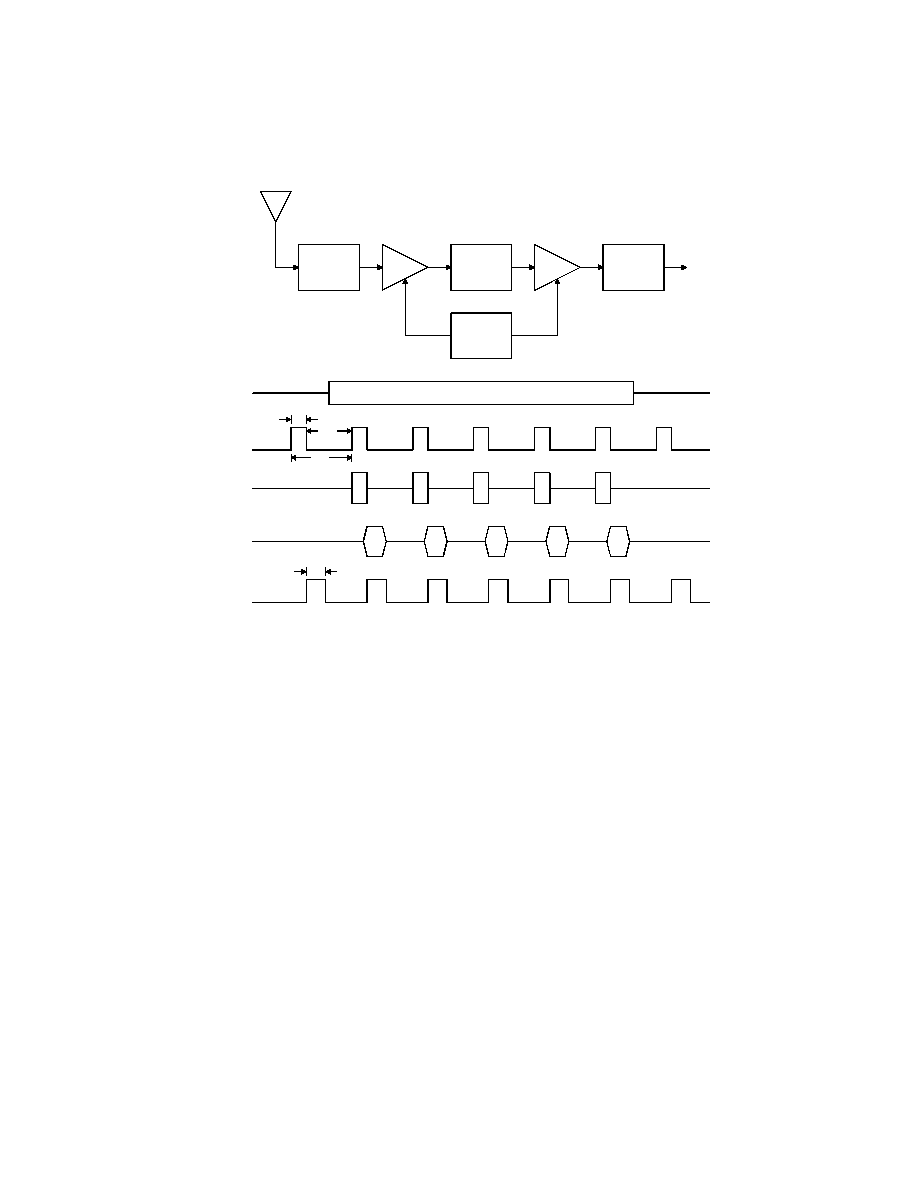
35
Copyright 2002 RFM
ASH Receiver Block Diagram & Timing Cycle
Antenna
Pulse
Generator
SAW
Delay Line
SAW Filter
RFA1
RFA2
Data
Out
Detector &
Low-Pass
Filter
RF Data Pulse
P1
P2
RFA1 Out
RF Input
P1
Delay Line
Out
P2
t
PW2
t
PW1
t
PRI
t
PRC

36
Copyright 2002 RFM
ASH Transceiver Block Diagram
RFA1
RFA2
TXA1
TXA2
Log
Antenna
RFIO
Detector
BB
LPFADJ
PRATE
P
WIDTH
RXDATA
AGCCAP
THLD2
THLD1
Power Down Control
Gain Select
AGC Set
AGC Reset
BBOUT
DS2
DS1
AND
Ref
Thld
PKDET
Ref
AGC
20
81
7
18
14
15
3
9
5
6
4
7
13
11
12
VCC1: Pin 2
VCC2: Pin 16
GND1: Pin 1
GND2: Pin 10
GND3: Pin 19
RREF: Pin 11
CMPIN: Pin 6
Low-Pass
Filter
Peak
Detector
dB Below
Peak Thld
SAW
Delay Line
Modulation
& Bias Control
ESD Choke
SAW
CR Filter
TX IN
CN
TRL1
CN
TRL0
R
TXM
TX
MOD
R
PR
R
PW
Pulse Generator
& RF Amp Bias
C
AGC
AGC
Control
Threshold
Control
R
TH1
R
TH2
R
REF
R
LPF
C
BBO
C
PKD
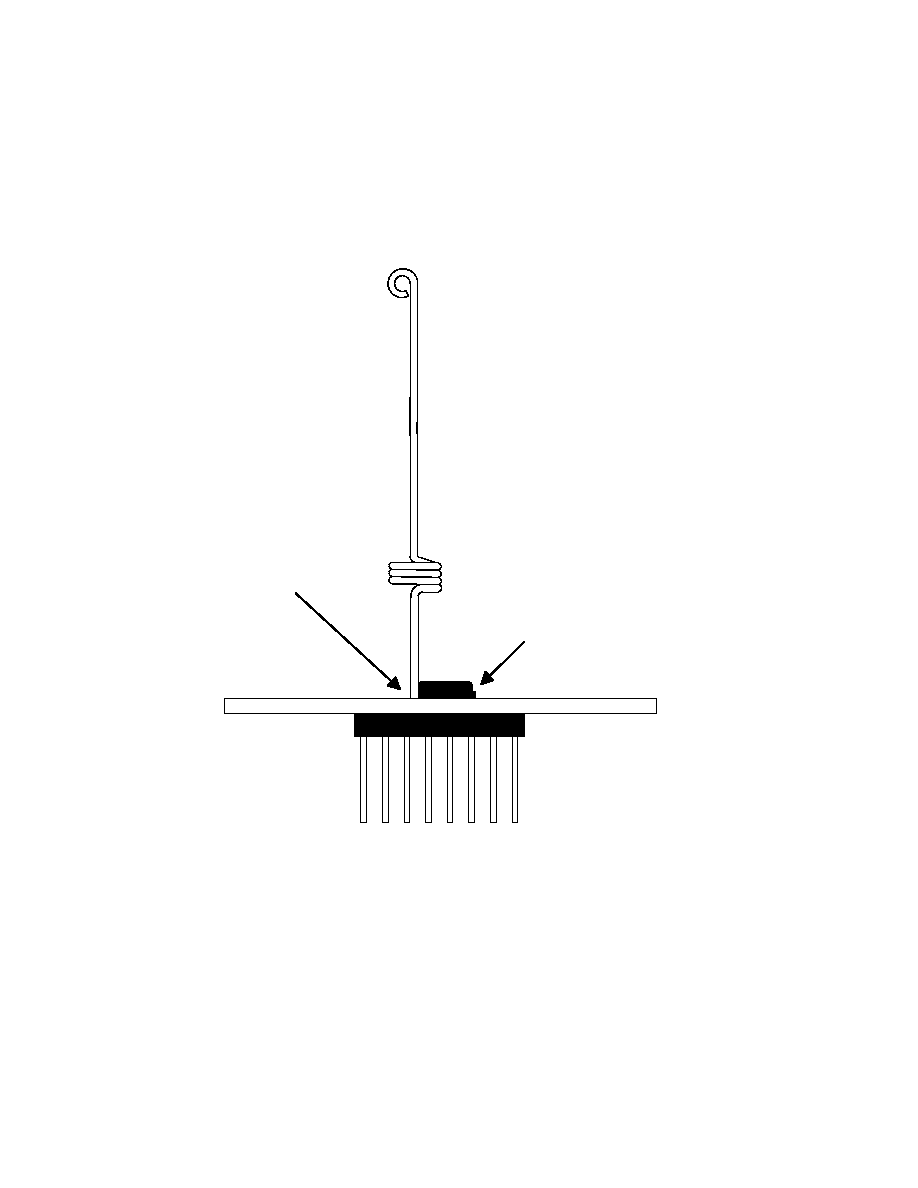
37
Copyright 2002 RFM
DR1200A/DR1201A Data Radio Board
Antenna Mounting Detail
View From Antenna Port of PCB
See component placement
Dwg (Top View) for Antenna
Pad location.
Mount antenna perpendicular
to the Printed Circuit Board
as shown.
TR
Transceiver
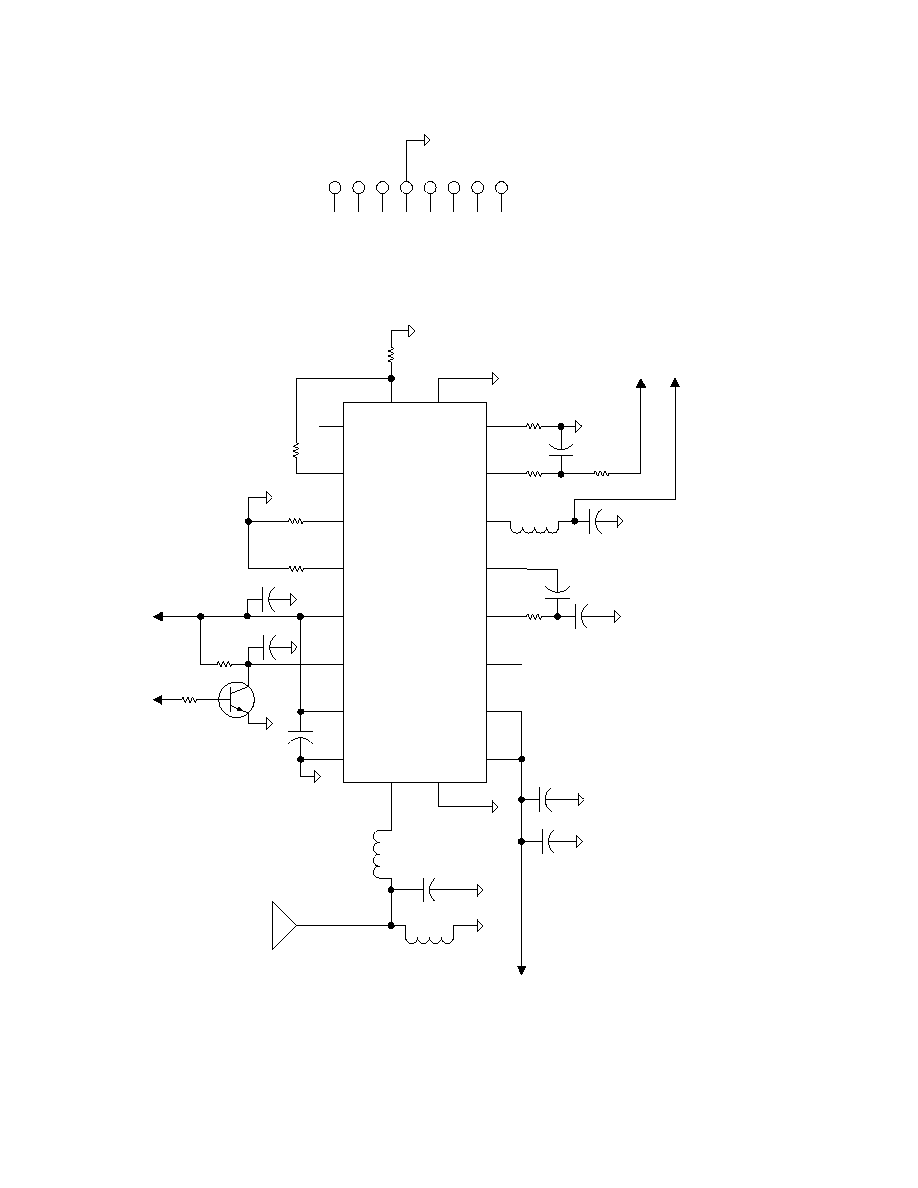
38
Copyright 2002 RFM
Schematic, DR1200A/DR1201A
Date: 12/19/2001, LM
Modulation Input
P1-1
GND
1
2
3
4
5
6
7
8
Data Out
Vcc
Not Used
Vcc
PTT
Vcc
Data In
P1
Data Output
P1-8
1
2
345
678
9
10
11
12
13
14
15
16
17
18
19
20
U1
R2
R3
R4
R6
R5
C3
L2
L1
ANT
R1
C1
+ 3 VDC
P1-2
C9
+
C2
R7
C8
L3
C5
PTT
P1-3
Q1
R9
R8
C6
C7
C4
+ 3 VDC
(U1, Pin 3)
C10
R10

39
Copyright 2002 RFM
DR1200A/DR1201A Bill of Materials
Ref Des
Qty
RFM P/N
Description
PCB1
1
400-1528-004X1
Printed Circuit Board
U1
1
TR1000/TR1001
TR1000 for DR1200A, TR1001 for DR1201A
L1
1
500-0583-100
Inductor, SMT, 10 nH, (Coilcraft 0805HT-10NTJ)
L2
1
500-0583-101
Inductor, SMT, 100 nH, (Coilcraft 0805CS-101TK)
Q1
1
500-0183-001
Transistor, SOT, MMBT2222L
C1, C6
0
Not Used
C2, C4, C5, C7
4
500-0621-101
Capacitor, SMT, 100 pF, 5%, 0603
C3
1
500-0621-154
Capacitor, SMT, 0.15 uF, %10, 0603
C8
1
500-0621-682
Capacitor, SMT, 0.0068 uF, %10, 0603
C9
1
500-0675-106
Capacitor, SMT, 10 uf, Kemet T491B106K006AS
C10
1
500-0675-273
Capacitor, SMT, 0.027 uF, %10, 0603
R1
1
500-0620-274
Resistor, Chip, 270K, 0.1 W, 5%, 0603
R2, R6
2
500-0620-334
Resistor, Chip, 330K, 0.1 W, 5%, 0603
R3, L3
2
500-0620-001
Resistor, Chip, 0.0, 0.1W, 0603
R4
1
500-0828-104
Resistor, Chip, 100K, 0.1 W, 1%, 0603
R5, R10
2
500-0620-472
Resistor, Chip, 2.4K, 0.1 W, 5%, 0603
R7
1
500-0620-123
Resistor, Chip, 12K, 0.1 W, 5%, 0603
R8
1
500-0620-333
Resistor, Chip, 33K, 0.1 W, 5%, 0603
R9
1
500-0620-273
Resistor, Chip, 27K, 0.1 W, 5%, 0603
P1
1
500-0644-001
Header, 8 Pin
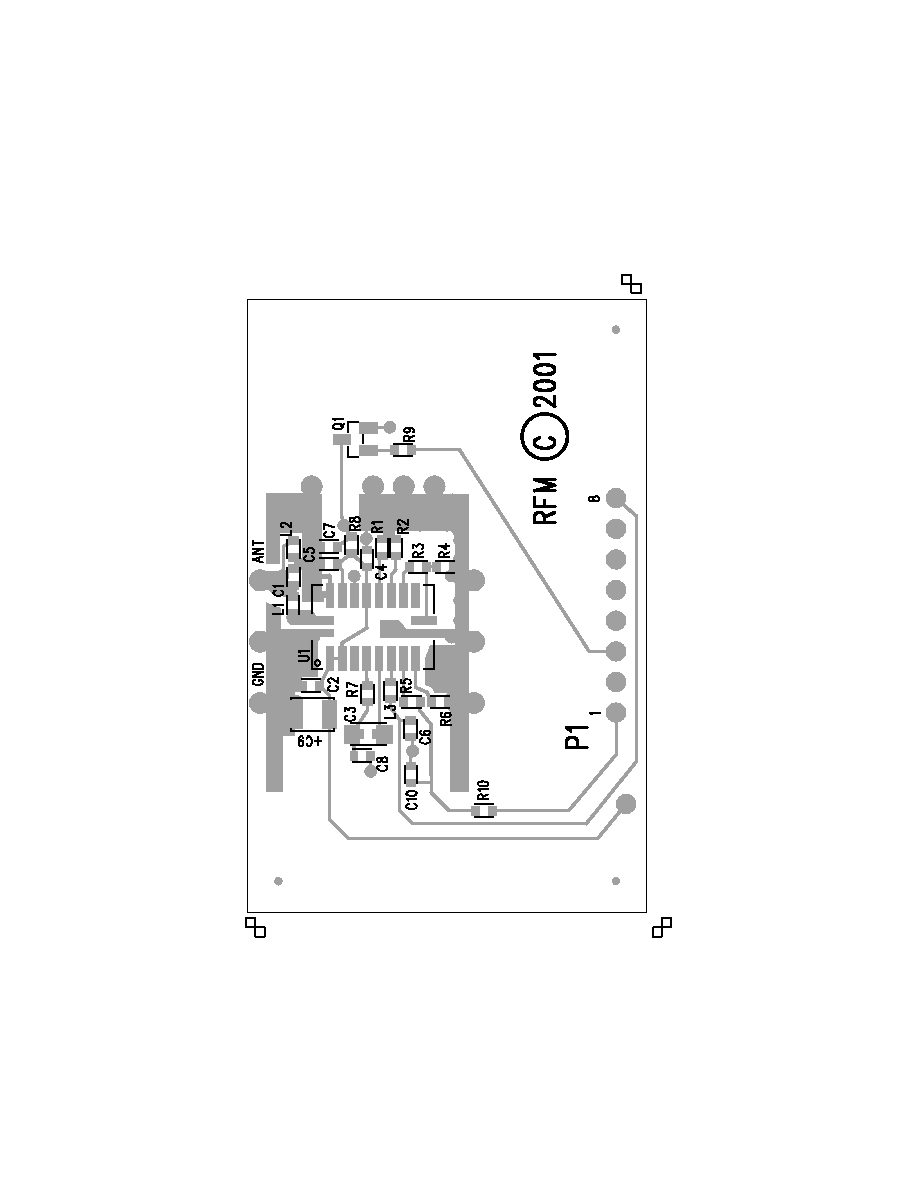
40
Copyright 2002 RFM
DR1200A/DR1201A Top Side Component Placement
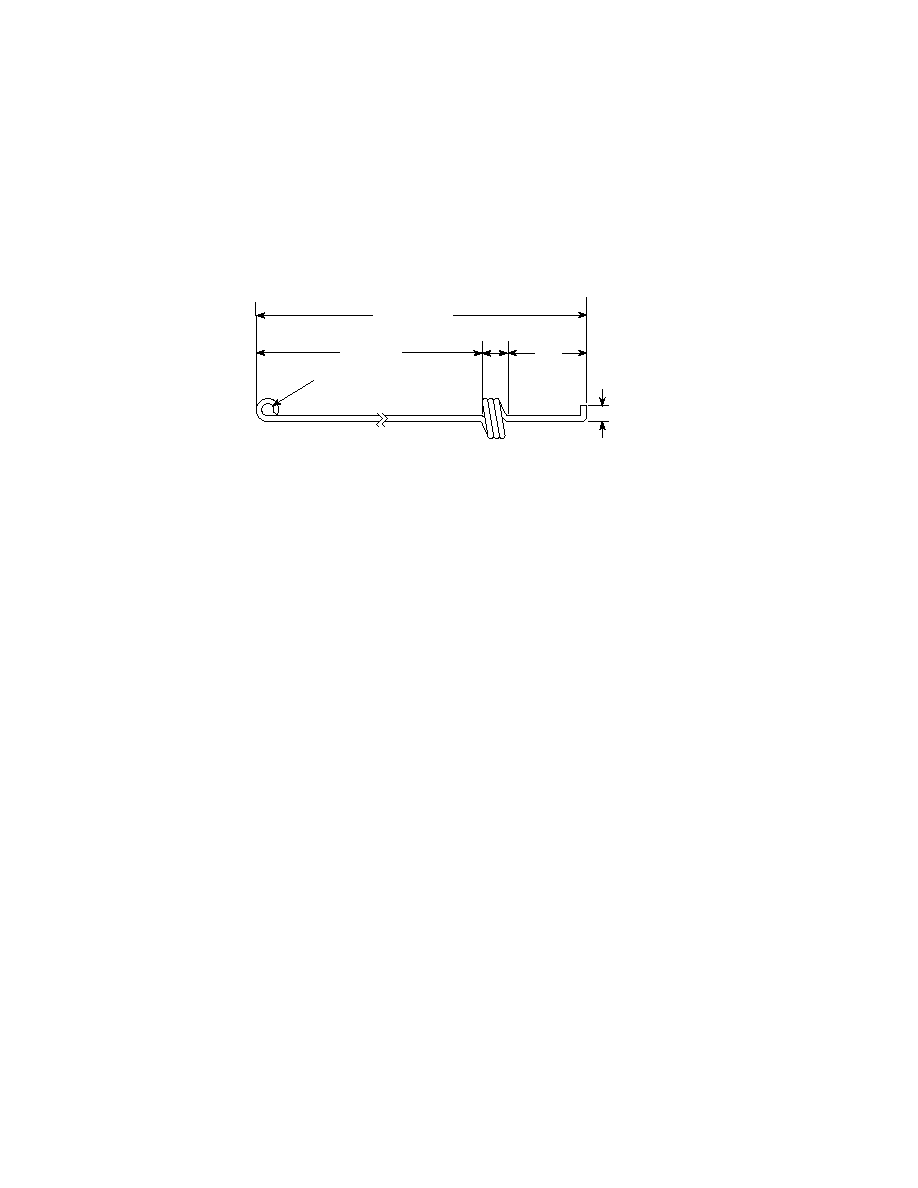
41
Copyright 2002 RFM
916.5 MHz Test Antenna Drawing
Not drawn to scale. Units in inches.
22 AWG insulated solderable magnet wire.
916.5 MHZ ANT
7/07/98 LAM
(c) 1998 RFM
R.03
.10
.40
1.45
Strip insulation to
bare copper approx.
.125 min, .150 max.
3 turns close wound on .130 in. dia.
400-1309-001
Finished ID = .130, +/- .003
+/- .005
1.950
+/- .025

42
Copyright 2002 RFM
868.35 MHz Test Antenna Drawing
Not drawn to scale. Units in inches.
22 AWG insulated solderable magnet wire.
868.35 MHZ ANT
7/07/98 LAM
(c) 1998 RFM
R.03
.11
.40
1.50
Strip insulation to
bare copper approx.
.125 min, .150 max
3.5 turns close wound on .125 in. dia.
Finished ID = .125, +/- .003
400-1406-001
2.010
+/- .025
+/- .005
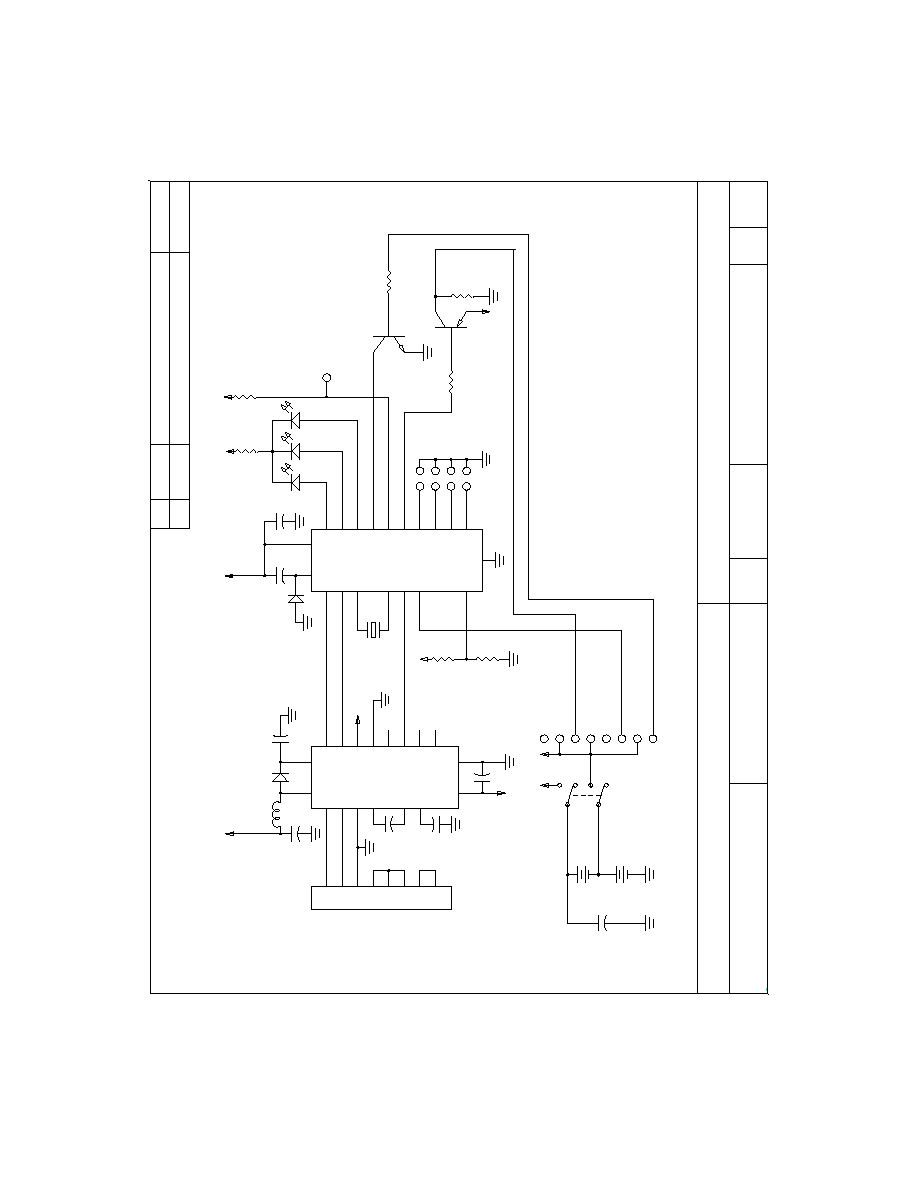
43
Copyright 2002 RFM
PB1001-2 Protocol Board
CODE IDENT
2U874
DALLAS, TEXAS 75244
DRAWN BY/DATE:
RF Monolithics, Inc.
CHECKED/APPROVED
Lee A. Mrha 5Mar99
TITLE:
SIZE
A
444-1001-003
SCHEMATIC, Protocol Bd., 19.2Kbs
DWG.
NO.
1/1
REV
X
SHEET
REV
NOTES:
ECN NO.
DESCRIPTION
APP/DATE
2U874
+
+
+
+
3
2
5
7
1
8
4
6
12
14
11
18
16
15
11
9
9
7
4
+4.5V
8
13
3
10
2
6
5,17,20
+4.5V
+4.5V
+4.5V
2
3
X1
4
5
1
+
20
18
13
VREF
+
C6
C3
C2
12
+4.5V
R1
D3
D4
D5
11
9
8
6
+4.5V
J1-1
RRX
RTX
+3V
PTT
R5
R6
7
19
17
16
15
14
+
+3V
C1
J1
J2
L1
D
1
C4
C5
U1
U2
MAX218
D2
C7
C8
Q1
Q2
1 DATA IN (RTX)
2 TX VCC
3 (PTT)
4 RX VCC
5 GND
6 (VREF)
7 RX VCC
8 DATA OUT (RRX)
R4
ADDRESS
ID0
ID1
ID2
ID3
100uf
15uh
1N5819
1uf
1uf
1uf
10uf
1uf
.1uf
51K
10K
1.8K
10K
MMBT2222
MMBT
2907
22.118
NC
NC
NC
AT89C2051
MHz
1N4148
P2
1uf
10
+4.5V
R2
R3
154K
100K
+4.5V
S1
+3V
+1.5V
510K
R7
D3, D4, D5 are ultrabright
LED's with cathode to B+.
Polarity may vary with
different LED's.
+
+

44
Copyright 2002 RFM
PB1001-2 Protocol Board
Top Side Component Placement

45
Copyright 2002 RFM
PB1001-2 Protocol Board
Bottom Side Component Placement
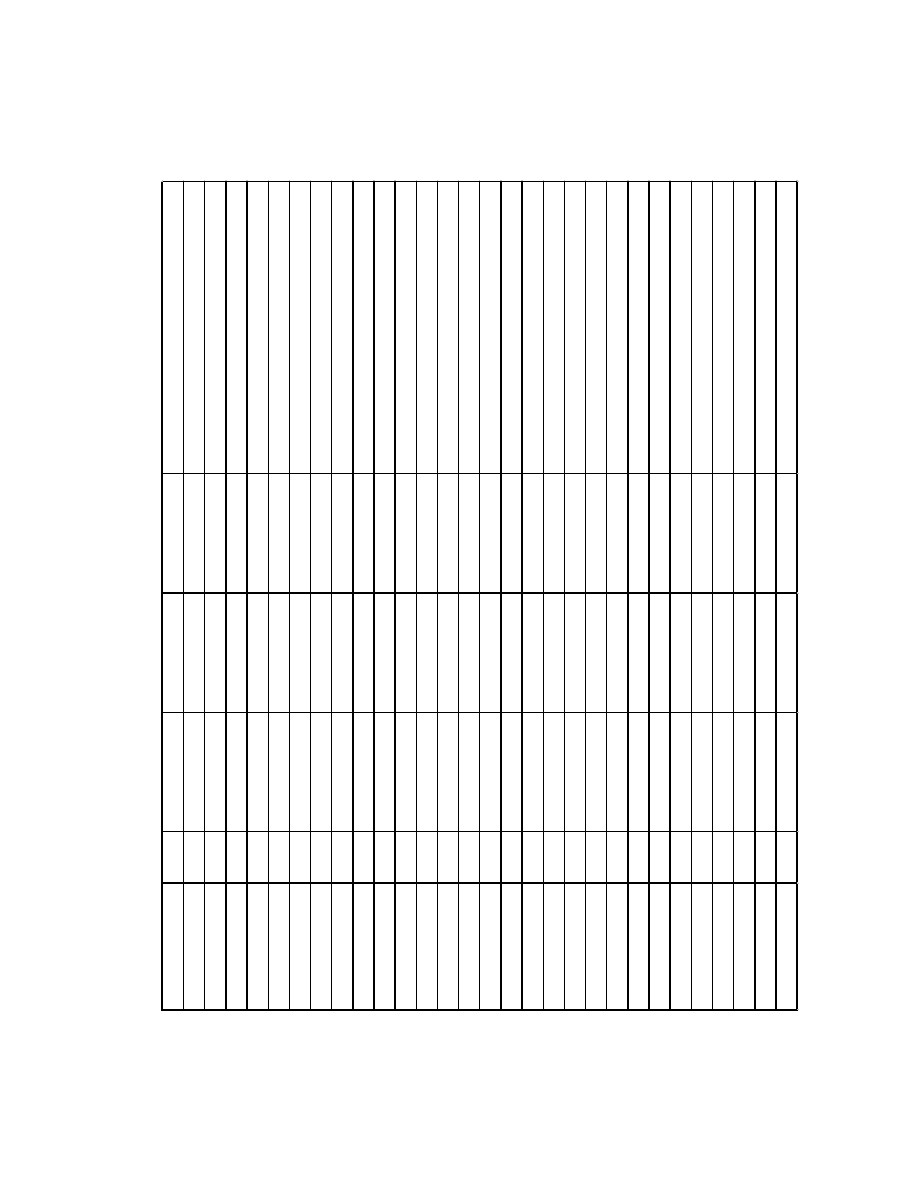
46
C
opy
ri
ght 2002 R
F
M
Ref Des
Qty
RFM P/N
Vendor
Vendor P/N
Description
PCB1
1
400-1354-001X1
Printed Circuit Board
C1
1
500-0669-001
Newark
51F2912
Cap, electrolytic, 100uf 25V
C2, C3, C4, C5, C7,
5
500-0243-105
Ne
wa
r
k
89F5035
Cap, SMT, Kemet T491A105K016AS
C6
1
500-0244-106
Ne
wa
r
k
92F5768
Cap, SMT, Kemet T491B106K006AS
C8
1
500-0623-104
Cap, chip, 0805, 0.1uf 25V
D1
1
500-0646-001
Digi-Key
1N5819CT-ND
Diode, Schottky, 1N5819
D2
1
500-0051-001
Digi-Key
1N4148CT-ND
Diode, High speed switching, JANTX1N4148
D3, D4, D5
3
500-0647-001
Digi-Key
LT1034-ND
T-1 Ultrabright LED
J1
1
500-0648-001
Digi-Key
WM3206-ND
PCB connector, Molex 22-02-2085
J2
1
500-0649-001
Newark
89N1583
PCB socket, 9 pin, SPC Technology DE9S-FRS
L1
1
500-0650-001
Newark
44F4268
Inductor, 15uh
P2
1
500-0651-002
Force Electronics
10-89-6084
8 pin dual row header, Molex 10-89-6084
Q1
1
500-0183-001
Motorolla
MMBT2222AL
T
ransistor, SOT, MMBT2222AL
Q2
1
500-0653-001
Newark
MMBT2907AL
T
ransistor, SOT, MMBT2907AL
R1
1
500-0022-182
Resistor, chip, 1.8K(J), .2w, 0805
R2
1
500-0732-001
Resistor, chip, 154K, .2w, 1%, 0805
R3
1
500-0673-104
Resistor, chip, 100K, .2w, 1%, 0805
R4
1
500-0022-204
Resistor, chip, 200K(J), .2w, 0805
R5, R7
2
500-0022-513
Resistor, chip, 51K(J), .2w, 0805
R6
1
500-0022-103
Resistor, chip, 10K(J), .2w, 0805
S1
1
500-0724-001
Augat
SSTS220PC
S
wi
t
c
h
,
DPDT
X1
1
500-0655-002
Digi-Key
CTX063-ND
22.1184 MHz Xtal, Series Resonant
2
500-0656-001
Digi-Key
ED3320-ND
20 pin IC socket
U1
1
500-0657-001
Digi-Key
MAX218CPP-ND
RS232C Transceiver, MAX218CPP
U2
1
500-0658-002
Ar
r
o
w El
ec
t
r
oni
c
s
AT89C2051-24PC
24MHz, PDIP, commercial temperature
1
500-0659-002
Keystone
2446
AAA battery holder, single cell
2
500-0660-001
Digi-Key
H560-ND
Screw, 6-32, 1/2 inch, nylon
2
500-0661-001
Digi-Key
H620-ND
Nut, 6-32, nylon
4
500-0665-001
McMaster Carr
9723K22
Bumper feet, .375 square
PB1001-2 Protcol Board Bill of Materials













































